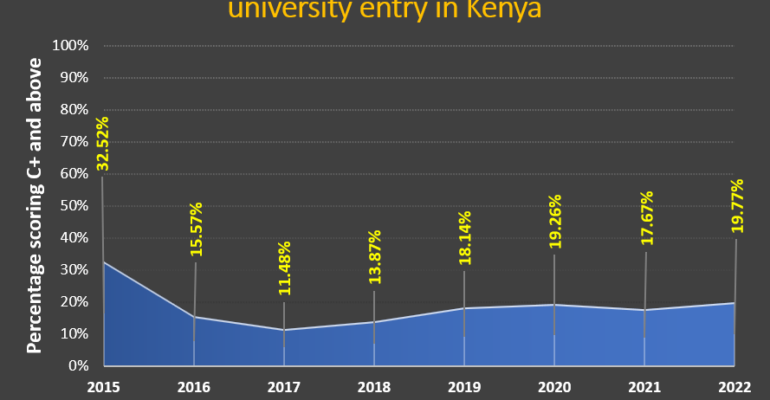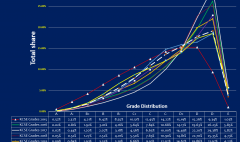?ℂ?? ???? – ???? ℝ??????: ?ℕ??ℝ?ℍ?ℕ? ??? ?ℝ?ℕ??
February 9, 2023 2023-05-26 12:54?ℂ?? ???? – ???? ℝ??????: ?ℕ??ℝ?ℍ?ℕ? ??? ?ℝ?ℕ??
?ℂ?? ???? – ???? ℝ??????: ?ℕ??ℝ?ℍ?ℕ? ??? ?ℝ?ℕ??
?ℂ?? ???? – ???? ℝ??????: ?ℕ??ℝ?ℍ?ℕ? ??? ?ℝ?ℕ??

#Education remains a timeless pillar of socioeconomic transformation and access to knowledge empowers individuals to make key decisions. The integrity of national examinations is the moral compass of a country’s quality of education.
?????? ????-?????? ????????
Kenyans are raising curious questions, if not an outright uproar, on the results of the pre-college qualification examination released in January 2023. An eight-year trend analysis of the results of the Kenya Certificate of Secondary Education (KCSE) examinations from 2015 to 2022, however, reveals a key message that should easily challenge popular views. At first glance, only the 2015 KCSE results display a curve that is out of phase with the general distribution traced by the seven other curves in this bracket. The drastic shift in governing examinations that a new crop of government officials in the Ministry of Education effected has been understood to be the cause of the new trend that emerged from 2016 – leading to a substantial reduction in the share of secondary school graduates qualifying to join public universities directly, from more than 30% to less than 20% ever since.
Evidence informed by data introduces a new angle from which the ongoing uproar and attacks on the 2022 KCSE results should be scrutinised. Anomalies in the 2022 KCSE results, if any, are anything but the overall distribution of the examination grades Kenya has been witnessing since 2016. As it is, the statistical distribution of the grades still leaves open questions on the geographical spread and concentration of the grades, hence the important aspect of spatial justice in educational outcomes, and governance in general.
????????? ?? ????????? ??????? ?? ?????
The 8-4-4 system has been best known for its stiff exam-oriented sieving process that has been cutting off the masses from attaining the grades needed for admission to the limited number of public universities in Kenya. Kenya has less than 100 universities as opposed to more than 400 in a country like Germany. Kenyans, especially the Generation X group, can boast a crisp memory and experience of the sunrise and sunset days of the 8-4-4 system of education. The system was introduced in 1985 to replace the 7-4-2-3 system that was started in 1967. It can be remembered that in its early days, the 8-4-4 system’s university entry grade for government-sponsored students used to be C+ (a mean of 6.5 – 7.4 out of 12 points), but the entry grade rose to B as the pass rate increased and self-sponsored students took up places at public universities due to the introduction of parallel degree programmes in the late 1990s. The 8-4-4 system recently gave way to the new 2-6-6-3 system, which features a competency-based curriculum (CBC). As of now, the last 8-4-4 cohort will sit the final Kenya Certificate of Primary Education (KCPE) examinations in 2023 and KCSE in 2027.

????? ??? ????? ?? ????????????? ??????????? ?? ?????????
In a knowledge-driven world experiencing the fulfilment of the earlier predictions conceptualised in the “Knowledge Doubling Curve”, sound education sector governance keeps rising to the top layer of key governance agendas. Years ago, claiming as scientists did that knowledge would progressively double in a matter of days, then hours, would be a laughable dream. Rapid access to knowledge is finally here with us, thanks to generative artificial intelligence (AI) with #ChatGPT domineering the latest technology headlines. How is the future of education and work?
More discipline and creativity will be demanded of learners and teachers as technology disrupts the education sector. Education is a complex adaptive ecosystem which has seen progressive transformation from being strictly linear and instructor-led (Education 1.0) to technology-enabled with learner-centric flexibility (Education 4.0 and Education 5.0). Consequently, the integrity of the training and assessment systems applied must be placed under the microscope.
????????? ????????? ?? ??????????? ???????
Concerned Kenyans have raised curious questions as to what used to happen in the 2010s, when individual schools could score too many A grades and the share of candidates attaining C+ and above used to exceed 30%. Runaway leakage and cheating were fronted as the reason for that non-representative performance pool. The last time Kenyans saw that in Kenya Certificate of Secondary Education (KCSE) was in 2015, following the tough measures put in place by the-then Cabinet Secretary for Education, Dr Fred Matiang’i, working together with the celebrated Prof. George Magoha, who proceeded to replace the former in the docket until 2022, just before the general elections.
The late Prof. Magoha has been eulogised for his valour, rigour, and candour as he was handling matters education including putting up a strong defence for the new competency-based curriculum. Symbolically, Prof. Magoha passed away on the International Day of Education, January 24, 2023 (Theme: To invest in people, prioritise education). The 2022 KCSE results and the first for the new government have, however, rekindled the debate on examination integrity. The findings of this analysis may help redirect the logical discourse on the results.
??? ??????? ??????
The following graphs reflect the analysed trends in KCSE results from 2015 to 2022. The following key messages ensue.
1. Only the 2015 curve is drastically different in grade distribution from the rest, with more than 30% attaining at least C+ as opposed to less than 20% from 2016 to 2022.
2. The results have been skewed towards Ds, which more than 50% of the candidates have been scoring since 2016, as opposed to less than 50% in 2015.
3. The enrolment for KCSE has been increasing by approximately 50,000 annually, implying the number of candidates to sit the 2025 KCSE examinations will cross the one million mark.

???????????
Statistically, the latest KCSE results (2022 KCSE) mirror the curves realised over 2016-2021. The spatial dimension of the scores is the aspect that needs further scrutiny to understand the concentration of the grades by location and any drastic changes that could have led to the drastic spike or drop in the performance of individual schools.
Since 2016, the established trend has been that less than 20% of the KCSE candidates qualify to join public universities directly. A million candidates are expected in 2025, hence about 200,000 students to qualify to join university directly in that year if the grade is maintained at C+. This means that the expansion of university spaces and facilities needs to match the swelling number of qualified candidates who seek admission. Otherwise, the minimum qualifying grade to join public universities is bound to rise to balance out. In the long-term, there must be robust plans to increase the number and enhance the capacity of Technical and Vocational Education and Training (TVET) centres to absorb 80% of KCSE graduates into tertiary education. From 2025 onwards, this 80% share will translate to at least 800,000 new candidates for TVET annually. Strategic modelling and policy design in aid of rolling out plans to contain such anticipated scenarios must therefore be an urgent and important assignment for the Ministry of Education.
???? ????? ??????? ?????? ?? ??????? ?????, ??-????????? ?? Taitataveta University#EnactusEnactusKenya Taita Taveta University TTU students and alumni, and mentees of Impact Borderless Digital, as they air their independent and informed views on what the #futureofeducation#futureoflearning#FutureOfWork https://www.facebook.com/EduMinKenya/ need to be aware of. Listen to the recorded session: https://twitter.com/i/spaces/1YpKkgARrEyKj
This is the product of more than a decade of dedicated experience in research, skills development, training, and mentorship. Through mentorship and career development fora, IBD empowers youth with the knowledge, international exposure, and digital fluency they need to be emancipated global citizens with borderless influence for sustainable development.








